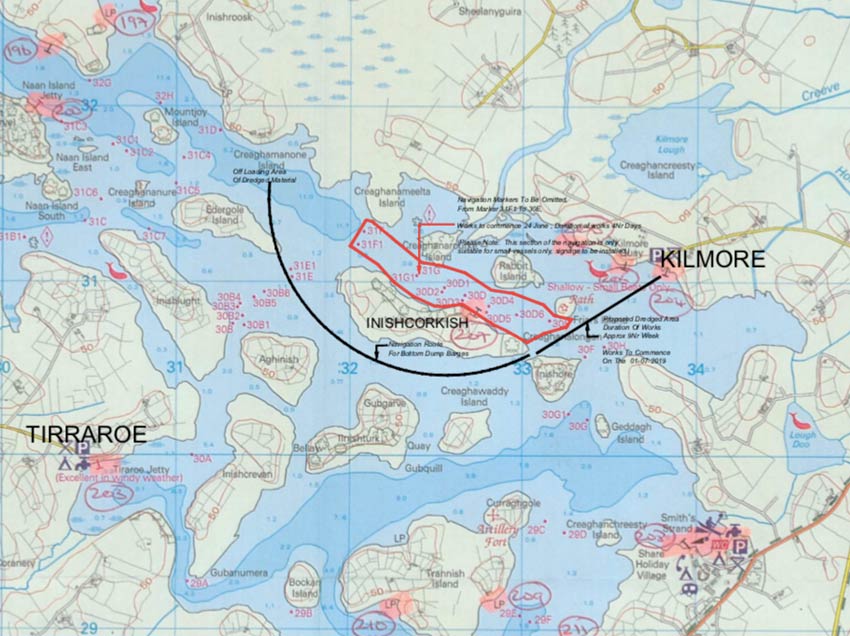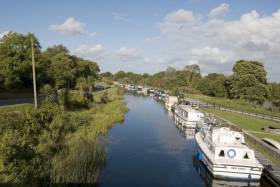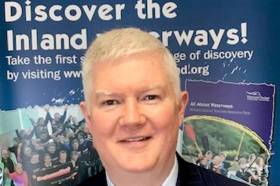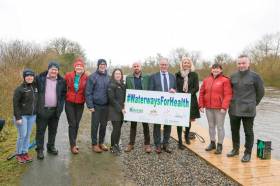Displaying items by tag: Waterways Ireland
Despite the growing demand for houseboat living in Ireland, there are only 28 residential moorings across the whole of the country, as RTÉ Radio 1’s Morning Ireland reports today (Wednesday 3 July).
Grand Canal Dock alone has a waiting list of some 215 hopefuls for its 20 places, and the programme hears from some of those fortunate enough to have made their home on Ireland’s inland waterways.
Waterways Ireland says it received as many as 10 queries a week from prospective houseboat residents — who will likely be waiting some time as only Grand Canal Dock and Shannon Harbour, with eight moorings, have provision for live-aboard homes.
Others make do with part-time waterways living, using the current 90-day permits to move around the country’s canals and rivers.
But with demand on the increase, it’s a situation that Waterways Ireland acknowledges has to change. RTÉ Radio 1 has more on the report HERE.
Waterways Ireland has issued Marine Notices related to a number of events taking place on Ireland’s inland waterways this weekend.
On the Royal Canal, a Junior Canoe Polo Competition will take place at Kilcock Harbour from 10am to 6pm tomorrow, Saturday 22 June.
Passage will be possible between 1pm and 2pm. Masters of other craft are requested to proceed at slow speed and with minimum wash and note any directions issued by the stewards.
On the Shannon-Erne Waterway, masters and owners of vessels are advised that they may experience short-term delays between Lock 1 at Corraquill and Ballyconnell Marina between 1pm and 6.30pm tomorrow due to the waterway’s 25th anniversary event.
Masters are requested to proceed at slow speed and heed any instructions issued by the event marshals.
Elsewhere on the River Shannon, the swimming element of a triathlon event will take place in Tarmonbarry on Sunday 23 June between 9.30am and noon.
Tarmonbarry lock will be closed to traffic during this time, and the N5 Shannon lifting bridge will also be closed, requiring large airdraft vessels to berth north of the bridge for the period.
A children’s swimming event will take place at 6pm on Saturday in Tarmonbarry, but this will not affect vessels in the navigation.
Masters are requested to proceed at slow speed and with minimum wash when approaching this section of the river and heed any instructions issued by the event marshals.
Meanwhile, on Upper Lough Erne, masters and owners of vessels are advised that dredging works are due to commence at Kilmore Quay on Monday 1 July and last for approximately nine weeks.
The map below shows the area to be dredged and the route the vessels will be taking in order to bottom-dump the material.

Masters of vessel are requested to proceed with additional caution in the vicinity of the dredging operations and dredging vessels.
Waterways Ireland thanks its customers for their co-operation in this and all other matters.
Hundreds of School Children Take Part In 2019 Biodiversity Week Programmes On Ireland’s Waterways
More than 600 primary level students across Ireland and Northern Ireland participated in Biodiversity Week workshops through Waterways Ireland’s education programme.
Biodiversity Week is one of seven different education programmes organised free of charge by Waterways Ireland both in the classroom and on the water throughout the school year.
This past week, seven workshops involving schoolchildren from 15 schools took place on Ireland’s inland waterways in Naas on the Naas branch, Drumshanbo on the River Shannon, Toomebridge on the Lower Bann, Mosstown on the Royal Canal, Ballyconnell on the Shannon-Erne Waterway, Robertstown on the Grand Canal, Killaloe on the River Shannon and Enniskillen on the Erne.
Tailored to each individual area, the workshops aimed to connect people with nature and communicate the importance of biodiversity, motivating people to play their part in protecting it.
It’s also about entertaining, showing the fun and wonder that can be found in nature, and inspiring people to learn more, see more and do more.
Students discovered the vast array of wildlife that call the waterways their home. Each group learned how to identify some of the plants and trees along the waterway and came face to face with some mini-beasts living there.
Environmental experts from across a range of disciplines delivered the workshops in conjunction with Waterways Ireland education and environment teams.
The Shannon-Erne Waterway begins its 25th year of operation tomorrow, Thursday 23 May.
It also marks start of a year of community, heritage and fun events all along the waterway linking Lough Erne in Co Fermanagh, through Co Cavan and into the River Shannon in Co Leitrim, taking in many towns and villages along its 63km length.
The largest cross-border infrastructure project of its time, the works involved the restoration of locks, dredging of the navigation channel, the installation of an electro-hydraulic lock operating system and the use of smart cards to operate the locks and service blocks which were placed at six locations along its length.
The Shannon-Erne Waterway has welcomed thousands of local and international boaters over the years, and introduced northern boaters to the south and southern boaters to the north, all bringing an economic dividend to places like Leitrim village, Keshcarrigan, Ballinamore and Ballyconnell.
Tomorrow the first of the year’s events, the Paddles Up Transition Year Programme reaches, its climax with a group of 100 students crossing the border on a 10km kayak paddle from the south to the north.
Paddles Up is a six-week programme involving learning the basic skills of kayaking and water safety and culminating in a 10km paddle. The students completing the programme will receive a qualification awarded by Canoeing Ireland, the national governing body, in either a Level One or Two Kayaking Proficiency Skills.
Further events are planned for the year including a visit of heritage boats to the Ballinamore Festival, exhibitions of heritage materials, oral history recordings and much more.
This include the Shannon-Erne Oral History Project, which is inviting contributions from people with memories of the waterway over the last 25 years.
Communities and activity clubs along the Shannon–Erne Waterway interested in organising events between now and May 2020 are asked to contact Waterways Ireland at [email protected] to be added to the events calendar.
To find out more about what’s on, find Waterways Ireland on Facebook.
Minister for Culture, Heritage and the Gaeltacht, Josepha Madigan, announced a new strategic partnership between Waterways Ireland and Rowing Ireland during the Get Going, Get Rowing #Blitzit Festival of Rowing on Grand Canal Dock on 9 May.
The partnership will seek to promote rowing programmes and clubs on the over 1,000km of inland waterways managed by Waterways Ireland.
It will also see a range of Rowing Ireland programmes, including Row for Life, the Get Going Get Rowing schools programme and Transition Year rowing coach programme, avail of Waterways Ireland facilities and sites to help promote improved levels of fitness, health and wellness across all ages in a fun and sociable environment.
Waterways Ireland, which is under the aegis of the Department of Culture, Heritage and the Gaeltacht, says it has seen a huge increase in the number of recreational users on and along all the waterways in recent years and there is now even more opportunity for people to try new recreational activities.
The new partnership allows Waterways Ireland and Rowing Ireland to join forces in promoting the health and well-being and social opportunities that are available through rowing in the great outdoors.
“For Waterways Ireland, partnerships are an ideal opportunity to encourage people to see inland waterways as a fitness and recreational opportunity for them,” said Sharon Lavin, head of marketing and communications at Waterways Ireland.
“Through working at a strategic level with Rowing Ireland, further programmes will be developed and people young and old will learn skills to help them stay fit and healthy for life.”
Rowing Ireland chief executive Michelle Carpenter added: “Our Get Going, Get Rowing programme — that has engaged 30,000 individual students in 2018 — is key to transitioning those from our school's programme to on the water rowing and activity on the water for life and our clubs.
“These values are significant elements of our strategic plan and we are thrilled to work hand in hand with our partners in Waterways Ireland.”
Further information on rowing programmes under this partnership can be found at RowingIreland.ie and www.WaterwaysIreland.org.
John McDonagh has been appointed acting chief executive officer of Waterways Ireland, the cross-border body for inland waterways accountable to the North South Ministerial Council under the 1998 British-Irish Agreement.
McDonagh is an English, history and politics graduate of UCD and he holds a Master’s in finance from the National College of Ireland.
He spent much of his career working in Shell Ireland and was formerly country manager. Prior to joining Waterways Ireland, McDonagh was sales and marketing director in Liberty Insurance. He has also consulted on a variety of projects across multiple sectors.
Network Of Inland Waterways Of Europe Launches New Website
The Network of Inland Waterways of Europe (NIWE) has launched its new website to celebrate and promote the many and varied benefits of Europe’s canals, lakes and rivers.
The NIWE, of which Waterways Ireland is a member, has been involved in numerous transnational projects boosting waterways organisations, local communities and businesses, and users alike.
The network’s shared objectives are to:
- Celebrate and promote the economic, social and environmental benefits of Europe’s inland waterways;
- Monitor and disseminate information on EU policy development and programmes;
- Support members’ participation in European initiatives and funding programmes;
- Promote the exchange of experience and knowledge transfer across the NIWE and among other relevant organisations and potential members;
- Create stronger engagement with the EU institutions to ensure the potential of European inland waterways is understood and reflected in EU policy and future programme development; and
- Collaborate with national and international organisations to achieve these stated objectives.
The new website at WaterwaysNetwork.eu is being touted as key tool in realising these objectives, serving as the NIWE’s marketing, project knowledge transfer and promotional platform for the future.
It it hoped it will also assist the network in developing future collaborative opportunities both with both European partners and local, regional and national partners.
Appeal For Sightings Of Invasive Coypu On Royal Canal In Dublin
Waterways Ireland advises all users of sightings on the Royal Canal at Ashtown of a large invasive rodent species that is highly damaging to river, lake and canal banks.
As previously reported on Afloat.ie, the coypu — also known as the nutria in the United States — is regarded as a destructive invasive species and pest, posing a threat to agriculture, the stability of river banks and even coastal defences.
The coypu is an EU-regulated species of concern with trade, transport and reproduction restrictions in place (No.1143/2014).
The large river rats can also carry a number of serious diseases communicable to humans and domestic animals.
Waterways Ireland says coypu eradication programmes can cost up to several millions of euro and are not always successful.
Most recently there were sightings of the rodents in Cork city two years ago, after a number were trapped by the National Parks and Wildlife Service (NPWS) in a tributary of the River Lee.
But their presence across the country in the capital raises concerns about their further spread throughout Ireland’s inland waterways.
Waterways Ireland has provided a checklist for how to spot a coypu, which are often confused with common otters:
- Large semi-aquatic rodent up to 1 meter in head to tail length. Features same in juveniles.
- It can weigh 5-9kg.
- It has webbed hind feet.
- Dark fur often with lighter ends and has a white muzzle.
- Has long cylindrical tail (not fur tail like otter) and small slightly protruding ears.
- Distinctive features are large bright orange-yellow incisor (front) teeth usually visible.
- Coypu are generally found near permanent water.
Do not attempt to engage, trap or harm these animals.
Waterways Ireland appeals for the public keep a lookout along the waterways and especially along the Royal Canal at Ashtown, and report sightings (with photos is possible) to any of the following:
- Waterways Ireland Environment Section 061-922141
- NPWS at [email protected] or your local NPWS ranger with details of location/date and a photo if available
- [email protected]
- records.biodiversityireland.ie
For more information visit species.biodiversityireland.ie.
Waterways Ireland Encourages Locals In Kildare, Carlow & Laois To Get ‘Walking On Water’ This Spring
Waterways Ireland has announced the launch of a walking programme along canal and river routes across Kildare, Carlow and Laois.
The aim of the Waterways For Health programme — in conjunction with Get Ireland Walking, and Local Sports Partnerships from Kildare, Carlow and Laois — is to immerse participants into natural waterway environments with guided support from county walking facilitators from Local Sports Partnerships.
“Waterways Ireland has seen a huge increase in the number of recreational and tourist users on and along all our waterways in recent years,” said Sharon Lavin of Waterways Ireland>
“With the provision of our Blueway and Greenway trails, we have now created even more opportunities for people to try new recreational activities. This also offers greater health and well-being and social opportunities for locals”.
For more information on the new Waterways For Health programme, its partners and their services, see GetIrelandWalking.ie and www.SportIreland.ie (to find your Local Sports Partnership).
#InlandWaters - Seán Kyne, Minister of State at the Department of Culture, Heritage and the Gaeltacht, has announced a €3.2 million investment by Waterways Ireland infrastructure on the Shannon Navigation at Meelick Weir.
The funds will be used for the restoration and replacement of the Meelick Weir walkway, the installation of tilting weir boards and remedial works to the weir structure.
The minister was joined on site yesterday (Friday 1 March) by Éanna Rowe, regional manager with Waterways Ireland and by Ministers of State Seán Canney Ciarán Cannon, along with Anne Rabbitte TD and local community representatives.
Meelick Weir was originally built in the 1790s as part of the Shannon Navigation. The weir, which is over 300 metres in length with a 12-sluice barrage, maintains and regulates the navigation level for that section of waterway between Athlone (Lough Ree) and Meelick (Lough Derg).
The weir and its walkway link the historic village of Meelick in Co Galway to Lusmagh in Offaly, and also link into the Hymany Way walking trail. The weir was damaged during storms in 2009 and the walkway was closed following further storms in 2015 and 2016.
Speaking yesterday, Minister Kyne said: “I am fully aware of the importance of this restoration to the counties of Galway and Offaly and in particular to the local communities of Lusmagh and Meelick who have been without the walkway for a number of years now.”
He added: “Meelick Weir is not just a walkway but a hidden gem on the River Shannon and its restoration shows the Government’s commitment to supporting all aspects of rural Ireland`s economic development.”
Éanna Rowe of Waterways Ireland said: “The development and re-instatement is critical to the management of the navigation and regulation of water levels.
“Reopening the connectivity between the communities of Lusmagh and Meelick and the re-instatement of the link to the Hymanny is a hugely positive and significant development for both communities.”
Waterways Ireland initiated design work on the project in 2012, completed the statutory environmental assessment and submitted planning for the project to Galway and Offaly county councils, which was given in 2017.
The works will involve the restoration of the weir, its walkway and the tilting weir boards along with the other critical infrastructure requirements (replacement of lock gates, jetty replacement, embankment works and bridge strengthening).
The new tilting weir system is being touted as a significant improvement in health and safety for employees managing water levels on site.
Following an open tendering procedure, a contractor will be shortly appointed and the project will be completed mid-2020.







































































